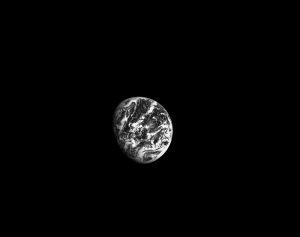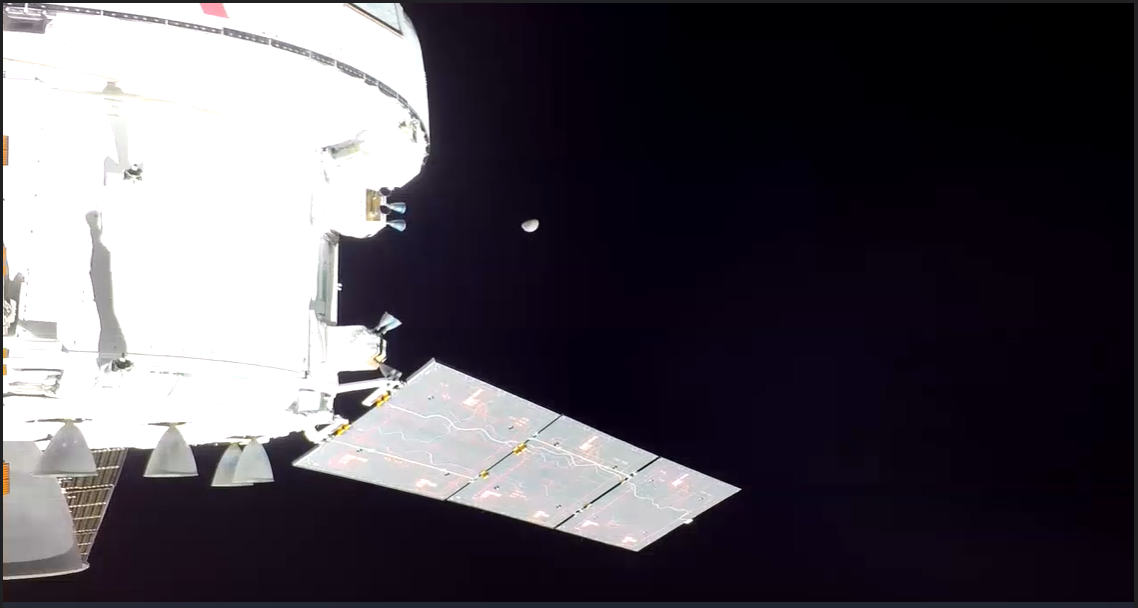Neues von der Artemis 1 - Mission:
Wed, 16 Nov 2022 06:02:08 +0000
Artemis
Teams have extended their planned 30-minute hold, and mission managers are expected to target a new time for launch. The Eastern Range and launch teams have since resolved an issue that caused a loss of signal from a radar site and are currently in the process of conducting required tests to ensure communication and tracking of the rocket and spacecraft.
Siehe auch die Originalnachricht:

 A view of Earth as seen from the Artemis I Orion capsule about 9 hours into flight on Nov. 16, 2022. (Image credit: NASA TV)
A view of Earth as seen from the Artemis I Orion capsule about 9 hours into flight on Nov. 16, 2022. (Image credit: NASA TV) A view inside the Artemis I Orion capsule with a view of the manikin ‘passenger’ recording data on conditions for the future crew members. (Image credit: NASA TV)
A view inside the Artemis I Orion capsule with a view of the manikin ‘passenger’ recording data on conditions for the future crew members. (Image credit: NASA TV) On the second day of the 25.5-day Artemis I mission, Orion used its optical navigation camera to snap black and white photos of planet Earth. Orion uses the optical navigation camera to capture imagery of the Earth and the Moon at different phases and distances, providing an enhanced body of data to certify its effectiveness as a method for determining its position in space for future missions under differing lighting conditions.
On the second day of the 25.5-day Artemis I mission, Orion used its optical navigation camera to snap black and white photos of planet Earth. Orion uses the optical navigation camera to capture imagery of the Earth and the Moon at different phases and distances, providing an enhanced body of data to certify its effectiveness as a method for determining its position in space for future missions under differing lighting conditions.
 Engineers activated the Callisto payload, Lockheed Martin’s technology demonstration in collaboration with Amazon and Cisco. Callisto will test voice-activated and video technology that may assist future astronauts on deep space missions.
Engineers activated the Callisto payload, Lockheed Martin’s technology demonstration in collaboration with Amazon and Cisco. Callisto will test voice-activated and video technology that may assist future astronauts on deep space missions.
 (Nov. 21, 2022) A portion of the far side of the Moon looms large just beyond the Orion spacecraft in this image taken on the sixth day of the Artemis I mission by a camera on the tip of one of Orion’s solar arrays. The spacecraft entered the lunar sphere of influence Sunday, Nov. 20, making the Moon, instead of Earth, the main gravitational force acting on the spacecraft. On Monday, Nov. 21, it came within 80 miles of the lunar surface, the closest approach of the uncrewed Artemis I mission, before moving into a distant retrograde orbit around the Moon. The darkest spot visible near the middle of the image is Mare Orientale.
(Nov. 21, 2022) A portion of the far side of the Moon looms large just beyond the Orion spacecraft in this image taken on the sixth day of the Artemis I mission by a camera on the tip of one of Orion’s solar arrays. The spacecraft entered the lunar sphere of influence Sunday, Nov. 20, making the Moon, instead of Earth, the main gravitational force acting on the spacecraft. On Monday, Nov. 21, it came within 80 miles of the lunar surface, the closest approach of the uncrewed Artemis I mission, before moving into a distant retrograde orbit around the Moon. The darkest spot visible near the middle of the image is Mare Orientale. (Nov. 21, 2022) – The Earth is seen setting from the far side of the Moon just beyond the Orion spacecraft in this video taken on the sixth day of the Artemis I mission by a camera on the tip of one of Orion’s solar arrays. The spacecraft was preparing for the Outbound Powered Flyby maneuver which would bring it within 80 miles of the lunar surface, the closest approach of the uncrewed Artemis I mission, before moving into a distant retrograde orbit around the Moon. The spacecraft entered the lunar sphere of influence Sunday, Nov. 20, making the Moon, instead of Earth, the main gravitational force acting on the spacecraft.
(Nov. 21, 2022) – The Earth is seen setting from the far side of the Moon just beyond the Orion spacecraft in this video taken on the sixth day of the Artemis I mission by a camera on the tip of one of Orion’s solar arrays. The spacecraft was preparing for the Outbound Powered Flyby maneuver which would bring it within 80 miles of the lunar surface, the closest approach of the uncrewed Artemis I mission, before moving into a distant retrograde orbit around the Moon. The spacecraft entered the lunar sphere of influence Sunday, Nov. 20, making the Moon, instead of Earth, the main gravitational force acting on the spacecraft. (Nov. 22, 2022) Flight Day 7, Orion’s Optical Navigation camera captures the far side of the Moon, as the spacecraft orbited 81.1 miles above the surface, heading for a Distant Retrograde Orbit. Orion uses the optical navigation camera to capture imagery of the Earth and the Moon at different phases and distances, providing an enhanced body of data to certify its effectiveness under different lighting conditions as a way to help orient the spacecraft on future missions with crew.
(Nov. 22, 2022) Flight Day 7, Orion’s Optical Navigation camera captures the far side of the Moon, as the spacecraft orbited 81.1 miles above the surface, heading for a Distant Retrograde Orbit. Orion uses the optical navigation camera to capture imagery of the Earth and the Moon at different phases and distances, providing an enhanced body of data to certify its effectiveness under different lighting conditions as a way to help orient the spacecraft on future missions with crew.